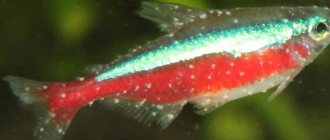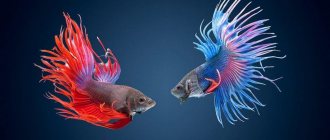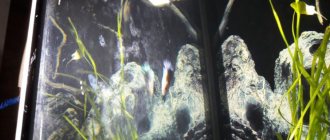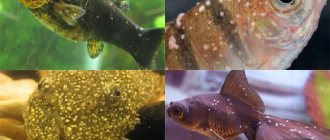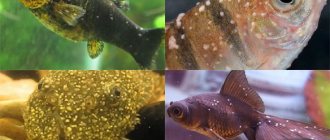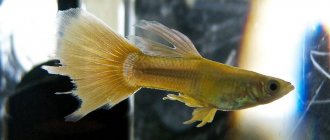Ichthyophthyriosis is an infectious disease of fish caused by the attack of an equally ciliated ciliate - Ichthyophthyrus. The disease is manifested by the appearance of small tubercles up to 1 mm in size on the body of the fish. The number of tubercles is growing every day.
This disease is also called semolina, since the aquarium fish is, as it were, sprinkled with semolina. Some beginning aquarists also call these tubercles: dots, bubbles, specks. However, these are precisely the tubercles - the place from which the ciliated parasites come out. Read more about the life cycle of the parasite on our forum - HERE .
Immediate treatment is necessary, otherwise the infusoria will exhaust the fish and it will die.
What is semolina
Semolina in aquarium fish, scientifically called “ichthyophthyriasis,” often affects even the most well-kept aquarium. The disease is infectious in nature and is caused by the ciliated ciliate parasite. The parasite affects: gills, fins, inner layers of skin. Externally, fish semolina looks like white tubercles or dots. Aquarists describe the disease this way: “the fish is covered with semolina.” These white dots are where the parasite accumulates. Ichthyophthiriasis proceeds aggressively, rapidly affecting every inhabitant. Treatment of semolina in aquarium inhabitants begins at the first signs of the disease, otherwise the fish die in less than a week. Semolina affects the immunity of fish, as a result of which pets are exposed to attack by other parasites and infections caused by bacteria and viruses. Often, when fish are affected by ichthythyriasis, other diseases are associated, so complex treatment is required. The most vulnerable small fish species and juveniles. They get sick and die first. But there is also a pleasant moment - this is resistance to the disease. Simply put, semolina in aquarium fish whose treatment was successful provides lasting immunity.
Dropsy
The main symptom of this disease is a greatly enlarged, swollen tummy. Red spots appear at the base of the fins and on the abdomen. Sick fish refuse food completely and quickly lose weight.
Causes of dropsy: viral infection, fungal infection, unbalanced diet, improper living conditions, decreased immune potential.
Treatment is effective only at the beginning of the disease. Complex antibiotics are used. The aquarium and equipment must be completely disinfected. If a betta fish has a very swollen belly, unfortunately, it dies.
Causes of semolina
The cause of the fish disease is the ciliated ciliate parasite. It lives in all bodies of water. All freshwater fish get sick with semolina. As for aquarium fish, infection occurs as a result of the introduction of ciliates with sick fish, snails taken from a natural reservoir or with natural soil that has not undergone heat treatment. For the development of a parasite in an aquarium, certain factors are needed:
- Poor aquarium hygiene,
- Errors in water parameters,
- Poor food and eating disorders,
- Too many fish
Prevention
In order to prevent ichthyophthyriosis, it is necessary to avoid introducing the pathogen into the aquarium. You should not buy sick fish. All new fish, even if they show no external signs of disease, must be placed in a separate quarantine tank for 2-4 weeks. Do the same with new plants. Do not allow drops of water in which fish or plants were kept in the pet store to get into the general aquarium. Decorations and soil are disinfected before being placed in the aquarium. The inhabitants of the aquarium are constantly monitored, since an outbreak of the disease can be triggered by any stress or drop in water temperature; You can even introduce the pathogen into the aquarium with tap water.
The causative agent of the disease
You need to know the enemy by sight. Knowing the nature of the pathogen, it is easier to cope with the disease of aquarium fish without resorting to radical measures.
The incubation period for the development of ciliates lasts from 7 days to two weeks. The parasite's favorite places are the inner layers of the skin and gills. After incubation, the first signs of damage appear on the body of the fish. The parasite feeds on the tissues of the host. In warm water, ciliates grow and multiply quickly. After some time, the tubercles burst, the ciliates leave the fish’s body and settle on all surfaces of the aquarium: plant leaves and decor. Cystoid formations appear on them, in which the larvae of the parasite mature. The formed larva leaves the cyst and drifts freely in the water column, waiting for its next victim. That is why overcrowding of the aquarium becomes the main reason for the rapid defeat of its inhabitants.
Oodiniosis: stuck together fins
With “velveteen disease,” the main manifestation is the presence of a light yellow coating on the body. There are other characteristic features:
- Breaking and splitting scales.
- Loss of color brightness.
- Apathy.
- Labored breathing.
- Drooping fins.
Appears as a result of poor care, hypothermia, or the introduction of individuals who have not undergone quarantine.
Antibacterial agents are used for treatment:
- Antipar (an antiseptic that affects fungus).
- Seraoodinopur (water condenser).
- Formamed (a drug against invasive diseases and maintaining a healthy environment).
- Ichthyofo (a substance based on two septic tanks: formalin and malachite green).
Please note: if at least one individual is unwell, it is necessary to carry out complete disinfection and treatment of the rest. Otherwise, the underwater beauties will infect each other, and the disease will drag on indefinitely.
During quarantine, maintain an elevated water temperature.
Symptoms of the disease
An attentive owner immediately notices semolina in aquarium fish. This sore has no hidden form, except for the incubation period. All signs are visible to the naked eye.
External signs
The body, fins and gills of the fish are covered with dermoid nodules. They are similar to semolina. The color of the grains ranges from white to light gray or light yellow. Small sizes: up to 1 mm. On dark fish the lesion is more noticeable than on light fish. Over time, the tubercles merge into large spots. At the last stage of the disease, wounds and ulcers appear on the body. Areas of skin begin to die, and the body becomes covered with necrotic spots. The fins take on a frayed appearance, as if they had been chewed off.
Behavior
The fish's behavior changes. At first, the pets behave normally. Occasionally someone fusses a little more or twitches his fins, but such moments go unnoticed. The fish's appetite remains good. Then the fish begin to get nervous: they rush around the aquarium, swim jerkily, scratch themselves on various objects in order to get rid of the infusoria and relieve the itching. Many float to the surface of the water and greedily swallow air. Someone freezes and practically does not move, there is no reaction to external stimuli.
Appetite
At the beginning of the disease, the fish have a good appetite. But as the disease progresses, it worsens and then disappears altogether. The fish refuse food.
WHAT DO COCKER FISH SICK WITH?
If your betta exhibits changes in appearance, behavior, and physiology, these are most likely symptoms of illness.
Sick males are less active, they swim sluggishly, and constantly hide. The body color becomes less bright, the fins are pressed to the body. Symptoms of some diseases also include protruding scales, spots on the body, a swollen body, and glued or torn fins.
Sometimes bettas can lie down on the bottom of the aquarium. Fish rest like this, but only if it does not last long. But this behavior over a long period of time is a symptom of malaise.
If the fish gets sick, pay attention to whether the symptoms of the disease appeared suddenly, and whether they are observed in other fish. Do not rush to give medications immediately, most likely the reason is the quality of the aquarium water. Be sure to measure water parameters: with a thermometer, litmus paper, and pH value. Check ammonia, nitrates and nitrites, temperature. Replace the water with fresh water and rinse the entire contents of the aquarium.
Treatment of ichthyophthyriosis
Previously, it was believed that semolina fish disease was easily treatable. But any form of life evolves, ciliates are no exception. And now it is becoming difficult to cure fish from this disease.
Treatment of semolina in fish should be started immediately at the first signs of the disease. An advanced infection will destroy the largest inhabitants in just a few days. It is important to remember that the defeat of one fish leads to the development of pathology in absolutely all inhabitants. Therefore, treating ichthyophthyriasis in a community aquarium is the best option, allowing you to get rid of the parasites entirely.
First you need to remove all equipment and decor from the aquarium. It is best to replace them with new ones. Can be treated with boiling water and soaked in furatsilin. Then develop a treatment method, taking into account the characteristics of all the inhabitants of the aquarium. The fact is that some drugs can cure some fish, but kill other fish.
The first thing to do is raise the temperature of the water. The increase threshold is 32 degrees. This is done to accelerate the development of ciliates and leads to their death. But you need to remember that not all aquarium inhabitants can withstand such temperatures. It is better to place such fish in another container and treat them using other methods.
An increase in temperature causes an immediate response from the fish's immune system, but can be harmful to those pets whose gills are severely damaged. This method must be used with caution so as not to kill the fish.
The chemical and medicinal method involves the use of such means as:
- Using table or sea salt
- Adding the drug “malachite green”,
- Treatment of water with hydrogen peroxide,
- The use of furatsilin,
- Medications.
Salt method
Treatment of semolina with salt is carried out in a common aquarium. The amount of salt depends on the volume of water. The calculation is as follows: 1 tablespoon per 10 liters of water. Preliminary dissolution of the salt is not required; it can be poured directly into the water. In this case, it is necessary to gradually increase the water temperature. The fish will float to the surface of the water. This is normal, since a concentrated salt solution is formed below, which is destructive for the pathogen. The duration of the procedure is 14 days. Then, for a month, the water is changed every week. Substitution volume 30%.
"Malachite green"
Highly toxic product, sanitary conditioner for aquarium water. They work with it wearing gloves. The medicine requires preliminary preparation. The solution is prepared at the rate of 0.09 mg per 1 liter of water. This concentration of the solution does not cause any particular harm. Of course, the inhabitants have a hard time, but they have no choice. Either treatment or death. The only thing that is taken into account is the presence of scaleless fish species. For such pets, the concentration is reduced to 0.06 mg/l. When using “malachite green”, a partial water change is necessary. This is done like this: replacing the water, then adding the drug. Treatment is carried out until the signs of the disease completely disappear and for several more days to consolidate the therapeutic effect.
Hydrogen peroxide
To treat semolina in a general aquarium with hydrogen peroxide, take a 3% solution. You need to add it carefully, as there is a risk of burning the fins. No more than 1 ml per 10 liters of water. Peroxide works like an oxygen mask. It becomes easier for “patients” to breathe, as peroxide enriches the water with oxygen.
Furacilin
An absolutely safe method of treating semolina with furatsilin will help you quickly get rid of the problem. To prepare the solution, take 1 tablet per 30–40 liters of water. Furacilin infusions are given every other day, replacing 30% of the volume of water.
Medicines
An ichthyologist will advise you on how to treat fish for semolina with medications. In the absence of one, they contact a veterinarian at the nearest clinic. If difficulties arise here, purchase the following medications:
- Antipar,
- Furazolidone,
- Delagil,
- Bicillin – 5,
- Contractal,
- Omnisan,
- Kostapur,
- Ektopur,
- Mikopur.
Useful tips
Semolina in fish is a dangerous disease that should not be treated with disdain. Regardless of the method chosen, along with treatment, experts recommend adhering to the following instructions:
- Increase aeration in an artificial reservoir.
- Control the required water temperature.
After the treatment of the fish is completed, it is necessary to move all the inhabitants into a separate container, leaving the aquarium empty. In an old aquarium, it is necessary to maintain a temperature of 32C, and install carbon filters to remove any remaining medications. There is no need to remove shellfish and vegetation from the reservoir.
Columnaria
The disease is caused by the gram-negative bacteria Flexibacter columnaris. The disease is also known as “mouth fungus” due to the similarity of symptoms to a fungal infection.
The following factors contribute to the development of the disease:
- overcrowding in aquariums;
- increased concentration of organic matter in water;
- violation of care rules;
- rapid breathing;
- insufficient aquarium volume.
Sick pets become lethargic, apathetic, swim jerkily, stay near the bottom, and hide in aquarium decor, plants, and shelters. The gills and oral cavity are severely affected. With severe damage, the gills become necrotic and acquire a light brown or, conversely, darker color. The accumulation of fluid in the eyes of fish signals damage to internal organs.
To prevent the spread of infection, treatment for columnaria begins in the initial stages of development. Systemic complex antibiotics are used. Disinfect the aquarium.




